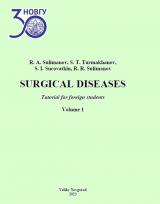Foreword .......................................................................................................... 5
1. Variety of clinical forms of acute appendicitis complications of acute appendicitis ........................................................................................ 6
1.1. Topographic anatomy of the appendix, caecum and colon. Atypical positions of the appendix................................................... 6
1.2. Complications of acute appendicitis (according to the stages of the flow) .............................................. 14
1.3. Chronic appendicitis ....................................................................... 18
2. Cholelitiasis and its complications. Acute cholecystitis. Cholangitis ...... 20
2.1. Cholelitiasis and its complications ................................................. 20
2.1.1. Anatomy of the gallbladder and bile ducts .......................... 20
2.1.2. Clinic of cholelithiasis ......................................................... 23
2.1.3. Diagnostics ........................................................................... 23
2.1.4. Treatment ............................................................................. 24
2.2. Acute cholecystitis ......................................................................... 26
3. Acute pancreatitis. Chronic pancreatitis ................................................... 33
3.1. Acute pancreatitis ........................................................................... 33
3.2. Pathogenesis .................................................................................... 37
3.3. Treatment of acute pancreatitis ....................................................... 41
3.4. Chronic pancreatitis ........................................................................ 45
4. Complications of gastric & duodenum ulcer ............................................ 53
4.1. Perforative gastroduodenal ulcer .................................................... 53
4.2. Pyloric stenosis ............................................................................... 70
5. Acute gastroduodenal bleeding ................................................................. 73
6. Acute gastroesophageal bleedings ............................................................. 86
7. Postoperative complications and their prevention .................................... 88
7.1. Early postoperative period .............................................................. 88
7.2. Complications of the early postoperative period ............................ 92
8. Peritonitis. Reasons for appearance. Clinic. Diagnostics. Treatment ......... 96
8.1. Classification .................................................................................. 96
8.2. Ethiology and pathogenesis ............................................................ 97
8.3. Clinic ............................................................................................. 102
8.4. Treatment ...................................................................................... 104
9. Acute intestinal obstruction ..................................................................... 110
10. Herniation of the abdominal wall. Postoperative and recurrent hernias ....................................................................................... 117
10.1. Anatomy of the anterolateral wall of the abdomen ........................ 117
10.2. Treatment ........................................................................................ 122
11. Mechanical jaundice. Intrahepatic and extrahepatic cholestasis. Cirrhosis of the liver. Portal hypertension syndrome. Acute liver failure ........................................................................................... 126
11.1. Mechanical jaundice ....................................................................... 126
11.2. Cirrhosis of the liver ....................................................................... 131
11.3. Portal hypertension syndrome ........................................................ 138
11.4. Acute liver failure ........................................................................... 143
12. Diseases simulating "Acute abdomen" ..................................................... 154
13. Open and closed abdominal injuries ......................................................... 170
13.1. General characteristics and classification of abdominal injuries ........................................................................ 170
13.2. Features and classification of damage to various organs ............... 173
13.3. Clinic ............................................................................................... 176
13.4. Diagnostics ...................................................................................... 178
13.5. Treatment ........................................................................................ 181
14. Diseases of the colon and rectum. Haemorrhoids. Prolongation of the rectum. Anal fissure. Acute and chronic paraproctitis. Nonspecific ulcerative colitis. Diverticulosis, colon diverticulitis ..................................................... 194
14.1. Haemorrhoids .................................................................................. 194
14.2. Rectal prolapse ................................................................................ 206
14.3. Anal fissure ..................................................................................... 215
14.4. Acute and chronic paraproctitis ..................................................... 219
14.4.1. Acute paraproctitis ............................................................... 220
14.4.2. Chronic paraproctitis (fistulas of the rectum) ...................... 222
14.5. Nonspecific ulcerative colitis ......................................................... 226
14.6. Diverticulosis, diverticulitis colon ................................................. 242
15. Retroperitoneal surgery ............................................................................. 251
16. Modern methods of treatment of surgical diseases of the abdominal cavity. Minimally invasive technologies in abdominal surgery ....................................................................................... 266
The textbook contains the basic notions and terms needed for learning the principles of general surgery, the basics of clinical examination of surgical patients, diagnosis of surgical emergency conditions, the strategy and arrangement of surgical patient care. A thorough description is given of new techniques and technologies, as well as the strategy for the choice of surgical care method. It is intended for third- and fourth-year students trained in the specialty 31.05.01 "General Medicine" in accordance with English language-based programs.
